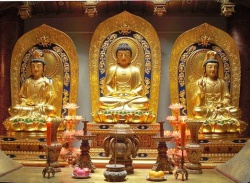Amitabha's Iconography
Altar display at a temple in Taiwan shows Amitabha in the center, flanked by Mahasthamaprapta on the viewer's right and Kuan Yin on the right. Amitabha can be very difficult to tell apart from Shakyamuni, as both are portrayed as possessing all the attributes of a Buddha but have no distinguishing marks. He can, however, often be distinguished by his mudra: Amitabha is often depicted, when shown seated, with the meditation mudra, with thumbs touching and fingers together (as in the Kamakura statue of Amitabha) or the exposition mudra, while the earth-touching mudra (with the right hand pointed downward over the right leg, palm inward) is reserved for a seated Shakyamuni alone. When standing, Amitabha is often show with his right arm bare and extended downward, with his
right hand facing outward. When not depicted alone, Amitabha is often portrayed with two assistants: Avalokiteśvara (Guan Yin) who appears on his right and Mahasthamaprapta Mahasthamaprapta (Da Shì Zhì) who appears on his left. The Panchen Lama, the second highest ranking lama after the Dalai Lama in the Gelugpa sect of Tibetan Buddhism, is believed to be an incarnation of Amitabha. Amitabha is red in color. In Tibetan Buddhism, red is the color of love, compassion, and emotional energy. His direction is the west. It is in this direction that sunset takes place and
indeed he is envisioned as the setting sun (red). He is seen as the supreme power and energy of nature, cast on an earthly plain, accessible to all sentient beings. It is little wonder that he is one of the most popular of all Dhyani Buddhas. His unique emblem is the lotus. He is thus associated with all the attributes of the lotus: gentleness, openness, and purity.
